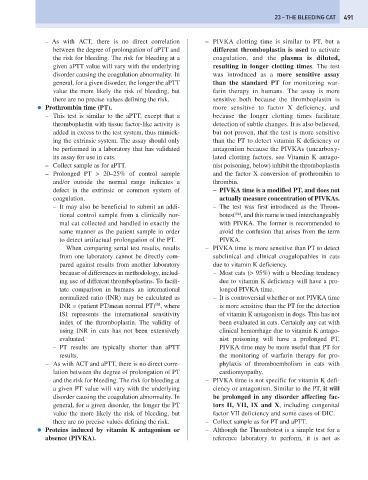Page 499 - Problem-Based Feline Medicine
P. 499
23 – THE BLEEDING CAT 491
– As with ACT, there is no direct correlation – PIVKA clotting time is similar to PT, but a
between the degree of prolongation of aPTT and different thromboplastin is used to activate
the risk for bleeding. The risk for bleeding at a coagulation, and the plasma is diluted,
given aPTT value will vary with the underlying resulting in longer clotting times. The test
disorder causing the coagulation abnormality. In was introduced as a more sensitive assay
general, for a given disorder, the longer the aPTT than the standard PT for monitoring war-
value the more likely the risk of bleeding, but farin therapy in humans. The assay is more
there are no precise values defining the risk. sensitive both because the thromboplastin is
● Prothrombin time (PT). more sensitive to factor X deficiency, and
– This test is similar to the aPTT, except that a because the longer clotting times facilitate
thromboplastin with tissue factor-like activity is detection of subtle changes. It is also believed,
added in excess to the test system, thus mimick- but not proven, that the test is more sensitive
ing the extrinsic system. The assay should only than the PT to detect vitamin K deficiency or
be performed in a laboratory that has validated antagonism because the PIVKAs (uncarboxy-
its assay for use in cats. lated clotting factors, see Vitamin K antago-
– Collect sample as for aPTT. nist poisoning, below) inhibit the thromboplastin
– Prolonged PT > 20–25% of control sample and the factor X conversion of prothrombin to
and/or outside the normal range indicates a thrombin.
defect in the extrinsic or common system of – PIVKA time is a modified PT, and does not
coagulation. actually measure concentration of PIVKAs.
– It may also be beneficial to submit an addi- – The test was first introduced as the Throm-
tional control sample from a clinically nor- botest™, and this name is used interchangeably
mal cat collected and handled in exactly the with PIVKA. The former is recommended to
same manner as the patient sample in order avoid the confusion that arises from the term
to detect artifactual prolongation of the PT. PIVKA.
When comparing serial test results, results – PIVKA time is more sensitive than PT to detect
from one laboratory cannot be directly com- subclinical and clinical coagulopathies in cats
pared against results from another laboratory due to vitamin K deficiency.
because of differences in methodology, includ- – Most cats (> 95%) with a bleeding tendency
ing use of different thromboplastins. To facili- due to vitamin K deficiency will have a pro-
tate comparison in humans an international longed PIVKA time.
normalized ratio (INR) may be calculated as – It is controversial whether or not PIVKA time
ISI
INR = (patient PT/mean normal PT) , where is more sensitive than the PT for the detection
ISI represents the international sensitivity of vitamin K antagonism in dogs. This has not
index of the thromboplastin. The validity of been evaluated in cats. Certainly any cat with
using INR in cats has not been extensively clinical hemorrhage due to vitamin K antago-
evaluated. nist poisoning will have a prolonged PT.
– PT results are typically shorter than aPTT PIVKA time may be more useful than PT for
results. the monitoring of warfarin therapy for pro-
– As with ACT and aPTT, there is no direct corre- phylaxis of thromboembolism in cats with
lation between the degree of prolongation of PT cardiomyopathy.
and the risk for bleeding. The risk for bleeding at – PIVKA time is not specific for vitamin K defi-
a given PT value will vary with the underlying ciency or antagonism. Similar to the PT, it will
disorder causing the coagulation abnormality. In be prolonged in any disorder affecting fac-
general, for a given disorder, the longer the PT tors II, VII, IX and X, including congenital
value the more likely the risk of bleeding, but factor VII deficiency and some cases of DIC.
there are no precise values defining the risk. – Collect sample as for PT and aPTT.
● Proteins induced by vitamin K antagonism or – Although the Thrombotest is a simple test for a
absence (PIVKA). reference laboratory to perform, it is not as

